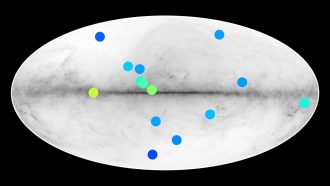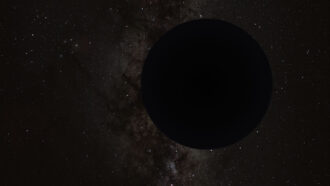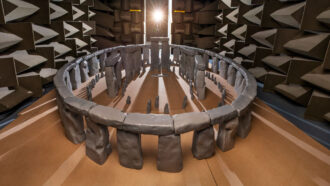HS-PS4-1
Use mathematical representations to support a claim regarding relationships among the frequency, wavelength, and speed of waves traveling in various media.
-
 Space
SpaceStars made of antimatter could lurk in our galaxy
Fourteen sources of gamma rays in our galaxy look like they could be antistars — celestial bodies made of antimatter.
-
 Planets
PlanetsSigns of a hidden Planet Nine in our solar system may be an illusion
Hints of the remote planet, also called Planet X, relied on clumped up orbits of bodies beyond Neptune. A new study suggests that clumping doesn’t exist.
-
 Physics
PhysicsScientists Say: Radiation
Radiation is the motion of energy through space as waves or particles.
-
 Physics
PhysicsLet’s learn about light
Light is a form of energy that moves in waves. Some light comes in waves we can see. Other waves are invisible to us — but still affect our world.
-
 Earth
EarthFin whales could help scientists map what lies below the seafloor
Fin-whale calls are loud enough to penetrate into Earth’s crust, offering scientists a new way to study the properties of the ocean floor.
-
 Physics
PhysicsPhysicists have clocked the shortest time span ever
The experiment revealed how long it takes light to cross a hydrogen molecule: just a couple hundred zeptoseconds.
-
 Physics
PhysicsWhat did you say? Fabric masks can really muffle voices
Some types of face masks muffle speech more than others — something that teachers should take into account.
By Sid Perkins -
 Space
SpaceOur feverish universe is getting hotter every day
For the first time, astronomers have taken the temperature of the cosmos at different times in its history. Galaxy clusters are cranking up the heat.
-
 Animals
AnimalsHere’s what bats ‘see’ when they explore the world with sound
High-speed cameras, fancy microphones and slick software are helping scientists get the best look yet at what bats perceive through echolocation.
-
 Tech
Tech‘Frozen smoke’ could protect electronics from annoying static
A fluffy material made from cellulose nanofibers and silver nanowires can protect electronic devices by blocking more than 99.99 percent of disrupting interference, a new study reveals.
By Sid Perkins -
 Humans
HumansChanging climates can take cooling tips from warm regions
When summer heat waves hit northern cities, people might look to keep cool using tropical building strategies — and forgotten architectural wisdom.
-
 Archaeology
ArchaeologyStonehenge enhanced voices and music within the stone ring
Scientists built a 'Stonehenge Lego' model in a sound chamber to study how sound would have behaved in the ancient stone circle.
By Bruce Bower